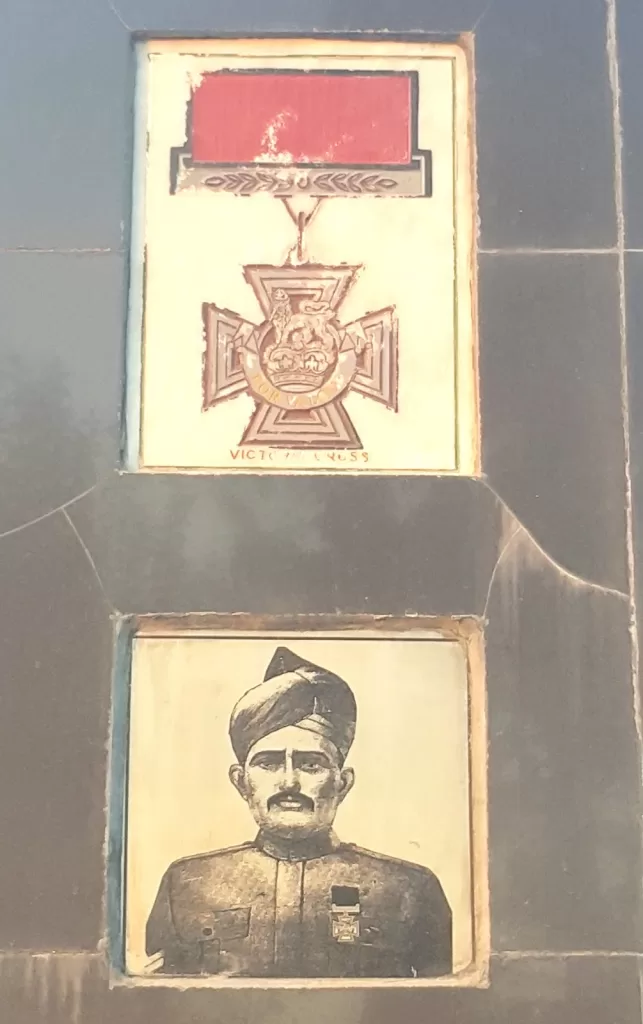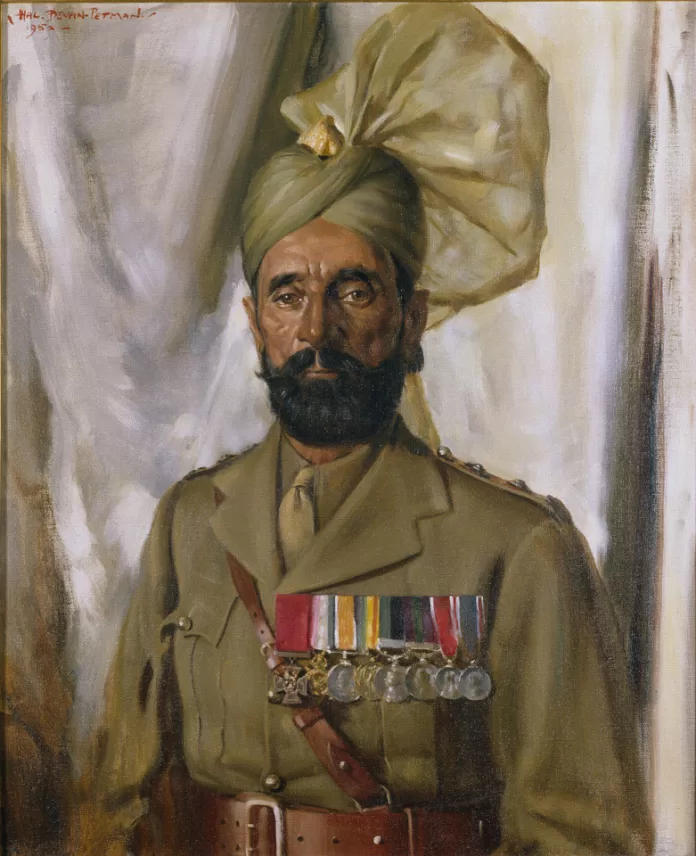Indian soldiers of British Indian army were not eligible for Victoria Cross (VC) until 1911. The highest award that an Indian soldier could get was Indian Order of Merit (IOM) prior to the eligibility for VC. Indian winners of VC belonged to all religions and ethnicities. Many Jat, Marhatta, Dogra, Garhwali and Gujar Hindus, Gurkhas, Sikhs, Punjabi, Pathan and Rajput Muslims fought with utmost bravery in battlefields allover the globe. Many rightfully earned the highest gallantry award.
Eleven VCs were awarded to Indian soldiers in First World War and twenty eight in Second World War. In First World War, six VCs were won in France and Belgium, three in Mesopotemia and two in Palestine. In Second World War, eighteen VCs were won in Burma, six in Italy, two in North Africa and two in East Africa. Only one VC was awarded for gallantry on Indian soil. Sepoy Ishar Singh of 28th Punjabis (later 4th Battalion of 15th Punjab Regiment and now 12 Punjab Regiment of Pakistan army) won this sole VC on Indian soil at Haidri Kuch in Waziristan.
Gobind Singh of 28th Cavalry (later 7th Light Cavalry) attached to 2nd Gardner’s Horse was the first VC winner from cavalry. Only one other cavalry soldier Badlu Singh won VC. He was from 14th Murray’s Jat attached to 29th Lancers. Only one VC winner Subedar Major Umrao Singh was from artillery (30th Mountain Regiment). Ganju Lama of Ist Battalion of 7th Gurkha Rifles who won VC in 1944 was a native of Sikkim and first Gujar VC holder was Sepoy Kamal Ram of 3rd Battalion of 8th Punjab Regiment (now 3 Baloch Regiment of Pakistan army).
Only two Indian commissioned officers won VC. First officer to win VC was Second Lieutenant (later Lieutenant General) Premindra Singh Bhagat (Engineers) and second officer winning this award posthumously was Lieutenant Karamjit Singh Judge of 4th Battalion of 15th Punjab Regiment (now 12 Punjab Regiment of Pakistan army). Permindra Singh Bhagat was serving with 21 Field Company and attached to 3rd Battalion of 12th Frontier Force Regiment (now 5 Frontier Force Regiment of Pakistan army) when he won his VC at the battle of Keren. Bhagat later rose to become Lieutenant General of Indian army; however he still maintained a connection with old PIFFERS (nick name of Frontier Force). At the time of partition, Sikh company of 3rd Battalion of 12th Frontier Force Regiment was absorbed in Sikh Light Infantry (SLI). Bhagat remained Colonel of SLI even after his retirement. Two Indian winners of VC have the same name Parkash Singh. One Parkash Singh of 4th Battalion of 13th Frontier Force Rifles (now 9 Frontier Force Regiment of Pakistan army) was a Dogra from Kashmir while other Parkash Singh of 5th Battalion of 8th Punjab Regiment (now 5 Baloch Regiment of Pakistan army) was a Sikh from Lyallpur (now renamed Faisalabad).
VC winners came from different regiments of Indian army. Gorkha Rifles won twelve VCs, Punjab Regiment nine, Frontier Force Rifles three, Baluch Regiment three, Garhwal Rifles two, and Rajputana Rifles two. Dogra, Sikh, Jat and Marhatta Light Infantry regiments won one VC each. Only two battalions have the honor of winning three VCs by Indians; 4th Battalion of 15th Punjab Regiment (now 12 Punjab Regiment of Pakistan army) and 2nd Battalion of 5th Gurkha Rifles. 2nd Battalion of 3rd Gurkha Rifles won two VCs (Karam Bhadur Thapa & Kulbir Singh Thapa). The last Indian VC holder Tul Bahadur Pun died in April 2011.
Muslim recipients of VC were part of the Indian army. Seven Muslim soldiers of Indian army won VC. Three VCs were awarded in First World War and four in Second World War. Of the seven Muslim VC recipients, four were Punjabi Muslims, two Pathans and one Muslim Rajput (Ranghar). Three VCs were awarded posthumously and these three are buried outside India-Pakistan. The longest surviving Muslim VC holder was Ali Haider who died in 1999.
Sepoy (later Subedar) Khudadad Khan (1888-1971)
He was the first Indian winner of VC. He won his VC in October 1914 in Belgium. He was a Punjabi Muslim from Chakwal area. Salt range of Rawalpindi district was a traditional recruiting ground of Indian army. Generations of Muslims, Hindus and Sikhs of the region proudly served in Indian army. Some writers have wrongly identified him as Pathan. There are two reasons for this confusion. One is his last name of Khan which is a common Pathan last name and second is the fact that a large portion of his battalion; 129th Baluchistan Infantry (later 4th Battalion of 10th Baluch Regiment and now 11 Baloch Regiment of Pakistan army) consisted of Pathans. This battalion went to the killing fields of First World War with six Pathan and two Punjabi Muslim companies.
Jamadar (later Subedar) Mir Dast Afridi (1874-1945)
Mir Dast was a trans-frontier Pathan of Maidan in Tirah valley. He was an Afridi belonging to Kambar Khel clan. He won his VC in April 1915 in France. He was the first Pathan to win VC. He was from 55th Coke’s Rifles (later 1st Battalion of 13th Frontier Force Rifles and now 7 Frontier Force Regiment of Pakistan army) but he won his VC when he was attached to 57th Rifles (later 4th Battalion of 13th Frontier Force Rifles and now 9 Frontier Force Regiment of Pakistan army). He was one of the most decorated soldier winning Indian Order of Merit (IOM) in 1903 and later also awarded Order of British India (OBI). He was wounded and suffered from the effects of poison gas forcing his discharge from the army.
His brother Jamadar Mir Mast Afridi was from 58th Vaughan’s Rifles (later 5th Battalion of 13th Frontier Force Rifles and now 10 Frontier Force Regiment of Pakistan army). He was serving with his own battalion in France. In March 1915, he deserted along with twenty four other Indian soldiers mainly Afridis to Germans. Some sources suggest that he was awarded Iron Cross by Germans but I have not been able to confirm it. It is also not clear whether he actually fought from German side although I doubt it.
Germans wanted to use these deserters for their own benefit to stir trouble among border tribes. Mir Mast made his way to Kabul where a small German-Turkish military team was planning to create troubles for British. This mission was headed by Captain Oskar Von Niedermayer and two Turkish army members were Khaira Bey and an Arab Muhammad Abid (serving as drill instructor at Kabul). There were already several small anti-British groups of different backgrounds working in tribal areas. Mir Mast helped to stir trouble in Tirah by rousing Afridis but there was no major trouble for British.

Naik (later Subedar) Shah Ahmad Khan (1879-1947)
He was a Punjabi Muslim from Chakwal area; a traditional recruiting ground of Indian army. He won his VC in April 1916 in Mesopotemia (Iraq). He was from 89th Punjabis (later 1st Battalion of 8th Punjab Regiment and now 1 Baloch Regiment of Pakistan army).
Jamadar Abdul Hafiz (1915-1944)
He was a Muslim Rajput (Ranghar) from 3rd Battalion of 9th Jat Regiment. He was awarded VC posthumously in April 1944 during the battle of Imphal on Burma front. He is the sole VC winner from Jat regiment.
Some writers wrongly identified him as Punjabi Muslim. The reason of this confusion is unfamiliarity with class composition of Indian army and the fact that he was from the area that is now in Indian Punjab. He was from the village Kalanaur. This village was inhabited by Muslim Rajputs also known as Ranghars and traditional recruiting ground of Indian army for this class. Class composition of Jat regiment clarifies it more clearly. In 1922 reorganization, 6 and 10 Jat regiments (Hindu Jat single class regiments), 18 Musalman Rajput Regiment (single Muslim Rajput class regiment) and 119 Infantry (Multan Regiment) were brought together to form five battalions of 9 Jat Regiment. Class composition of Jat regiment was 50 percent Hindu Jat, 25 percent Punjabi Muslims (from Gujrat, Poonch and cis-Sutlaj states) and 25 percent Muslim Rajputs. Army was rapidly expanded during Second World War. Additional Hindustani Muslim recruits from Haryana, Rajhasatn, United Provinces and Bihar were recruited in Jat regiment.
Lance Naik Sher Shah (1917-1945)
He was a Punjabi Muslim and won his VC posthumously in January 1945 on Burma front. He was from 7th Battalion of 16th Punjab Regiment (now 19 Punjab of Pakistan army).
Sepoy (later Naib Subedar) Ali Haider (1913-1999)
He was a Bangash Pathan from Kohat district. Most cis-frontier (settled districts) Pathan recruits of Indian army came from Peshawar and Kohat districts. He was from 6th Battalion of 13th Frontier Force Rifles (now 1 Frontier Force Regiment). He won his VC in April 1945 in Italy. Some writers have erroneously described him as the first Pathan VC winner which is incorrect. Subedar Mir Dast Afridi had won VC in 1915.
Naik Fazal Din (1921-1945)
He was a Punjabi Muslim from Hoshiarpur district. He won his VC in March 1945 in Meiktila on Burma front. He was from 7th Battalion of 10th Baluch Regiment (now 15 Baloch Regiment of Pakistan army).
Indian and Pakistani armies share a common history and memory of that shared bond is fading away. Soldiers of Indian army belonged to different religions and ethnicities but all were proud to serve the profession of arms. They fought side by side as comrades against a common foe and never imagined future hostilities between their communities.
Many post-independence writers of India and Pakistan look at the past through the new prism of nationalism that can cause some confusion. In India, most will honor only Hindu and Sikh soldiers of the Raj while in Pakistan only Muslim soldiers are remembered. Parkash Singh was a Sikh but native of Lyallpur now in Pakistan and he won his VC with 5th Battalion of 8th Punjab Regiment that was allotted to Pakistan. Pakistan can rightfully claim this brave son as its own. On the other hand, Abdul Hafiz was native of Kalanaur; now in India and he won his VC with 3rd Battalion of 9th Jat Regiment that was allotted to India. India can be proud of its son. Any one can be proud of such folks who performed beyond the call of duty and many gave supreme sacrifice to honor their oath.




